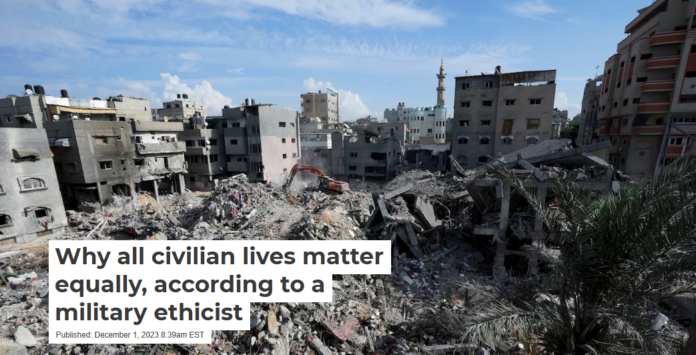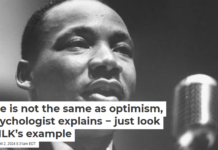

Jessica Wolfendale, Case Western Reserve University
Some commentators have criticized Israel for causing what is claimed to be disproportionate harm to civilians in its military response to Hamas’ Oct. 7, 2023, attack.
Others have defended Israel’s actions, claiming that such force – and the risk to civilians involved – is necessary to eliminate Hamas, which some Israelis believe poses an existential threat to Israel.
As of Nov. 25, according to health officials in the Gaza Strip, more than 14,000 Palestinians have been killed, the majority of whom are women and children.
But one of the arguments given by defenders of Israel’s actions is that, tragic though these deaths are, the harm inflicted on civilians is proportionate because it is outweighed by the importance of destroying Hamas.
But what does “proportionate” mean in the context of civilian deaths? And how should we assess Israel’s claims of proportionality against critics who argue that Israel’s actions have caused disproportionate harm to civilians? As a scholar of war crimes and military ethics, I argue that to assess these claims requires careful thought about what it really means to value civilian lives. If all civilian lives are morally equal, as international law holds, then the lives of civilians on both sides of a conflict should be treated with the same degree of respect.
Why targeting civilians is wrong
International humanitarian law, or IHL, prohibits direct attacks on noncombatants – a category that includes civilians as well as wounded and surrendered soldiers. IHL also prohibits direct attacks on civilian objects such as schools, religious centers and hospitals and other civilian infrastructure.
However, because it is impossible to avoid all harm to civilians in a war zone, IHL permits attacks on military targets that are likely to cause harm to civilians if two conditions are met: First, the foreseeable harm to civilians must be proportionate to the military advantage sought by the attack. And second, the choice of tactics and weapons – what is referred to in IHL as the “means and methods” – must also aim to minimize risk to civilians, even if it means putting more soldiers in harm’s way.
The prohibitions on directly targeting civilians and exposing civilians to disproportionate risk of harm exist because, under IHL, civilians have protected status as long as they take “no active part in the hostilities.” This means that, as stated in the Geneva Conventions – the set of international treaties governing the conduct of armed conflict – all civilians must be “treated humanely, without any adverse distinction founded on race, color, religion or faith, sex, birth or wealth, or any other similar criteria.”
Directly targeting civilians or exposing them to disproportionate harm is therefore wrong for the same reasons that it is wrong to kill or harm innocent people in peacetime. People who pose no threat to others deserve respect and protection from violence regardless of their nationality or group identity. To violate that respect in war is not only a war crime but a moral crime, which is why Hamas’ massacre of at least 1,200 Israeli citizens and the taking of 240 hostages is rightly condemned as an atrocity.

How should the lives of innocent people be weighed against important military objectives?
Proportionality and moral assessment
The condemnation of Hamas’ crimes is based on the same moral principle as the laws that protect noncombatants in war: All innocent people deserve protection.
However, scholars and legal experts disagree about how the legal framework laid out in the Geneva Conventions should be applied in war zones.
For example, in 1987 the International Committee of the Red Cross argued that the definition of “military advantage” – the advantage against which potential civilian harm must be weighed – should only include “ground gained” and “annihilating or weakening the enemy armed forces.”
But the 2016 U.S. Department of Defense Law of War Manual claimed that “military advantage” should also include other goals such as “diverting enemy forces’ resources and attention.”
There is also disagreement about what counts as “civilian harm.” For example, scholar Emanuela-Chiara Gillard argues that “civilian harm” should include psychological and physical harms; legal expert Dr. Beth Van Schaack argues that long-term harms should also be considered.
In short, there are no easy answers to questions about how to weigh harms against civilians against the value of military objectives. But while answers are difficult, there is a different way to frame this question: What does it mean – not just legally, but morally – to treat all civilian lives as equal, as the law requires?
As scholar Matthew Talbert and I argue, the first step in answering this question is to ask what a military force would accept if it were “their” civilians who were at risk of harm from military action.
That is the standard we should apply when assessing potential military actions that threaten harm to enemy civilians. We call this standard the “principle of the moral equality of noncombatants.” For example, Israel argued that its attack on Shifa hospital was justified because, it claimed, Hamas was hiding a command base and weapons under the hospital.
The hospital, which was running low on fuel, food and water, housed patients, including premature babies, and civilians seeking refuge from the conflict. According to footage shown in news reports, the attack left the hospital seriously damaged, filled with debris and lacking essential supplies for the remaining patients, who include the elderly and infirm.
Israel has released footage supporting its claim that there was a Hamas command center under the hospital. Does that mean Israel’s attack on the hospital meets the requirements of proportionality? In other words, was the harm to civilians caused by the attack – including the ongoing harm resulting from the loss of a major hospital – proportionate to the military value of destroying a Hamas command base?
In applying the principle Talbert and I proposed in our paper, the question would be phrased as follows: If Hamas was hiding a control base under an Israeli hospital and it was Israeli civilians at risk, would Israel think that attacking the hospital would be justified? If the answer is “no,” then the attack against Shifa hospital is also not justified.
This is because if the risk to Israeli lives outweighs the benefits of capturing a Hamas command base, then the risk to Palestinian lives should be given the same weight and lead to the same conclusion. Under IHL, all civilians are legally entitled to the same protection, regardless of their nationality.
Taking civilian lives seriously
Unfortunately, the debate about proportionality in the conflict between Israel and Palestine is only the latest of many debates about proportionality and civilian deaths in war zones.
For example, since 2001, the United States’ drone program has killed at least 22,000 civilians in Afghanistan, Iraq, Syria, Pakistan and elsewhere. A New York Times report on these deaths found multiple instances of “flawed intelligence,” cover-ups and cases of mistaken identity. Despite this record, civilians deaths still occur.
Using the principle of the moral equality of noncombatants to assess this track record would reveal whether the U.S. military is taking sufficient care to avoid harm to civilians. If the U.S. military would not accept these deaths – and the policies and practices that contribute to them – if U.S. civilians were at risk, then these deaths are unjustified.
This would mean that the drone program must change in order to treat civilians in Syria, Pakistan and elsewhere with the respect to which they are legally and morally entitled. This example illustrates that to meet the standards of IHL and the moral principles that underlie those standards, military forces must apply the principle of the moral equality of noncombatants. There is no legal or moral justification, I argue, for treating some civilians lives as less important than others.
This is a demanding principle. Applying it would be difficult – military and political leaders would have to accept that there might be military objectives that are not important enough to justify risk to civilian lives. And it would require acknowledging that some military objectives might be so important that even harm to “their” civilians might be justified.
But one of the functions of IHL is to “limit the suffering and damage caused by armed conflict.” This principle reflects the moral and legal status of civilians in IHL and could lead to greater respect for and protection of all civilians during conflict.
Jessica Wolfendale, Professor of Philosophy, Case Western Reserve University
This article is republished from The Conversation under a Creative Commons license. Read the original article.



















